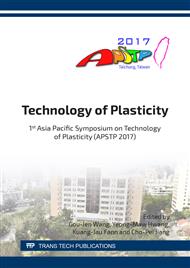[1]
J. H. Jang, B. D. Joo, S. M. Mun, C. J. Van Tyne, Y. H. Moon, Application of a direct laser melting process for fabricating a micropattern in bipolar plates used in direct methanol fuel cells, J. Eng. Manuf. 225 (2011) 1784-1791.
DOI: 10.1177/0954405410395859
Google Scholar
[2]
M. Van Stappen, K. De Bruyn, C. Quaeyhaegens, L. Stals, V. Poulek, Deposition and properties of thick corrosion and wear-resistant Ti2N coatings, Surf. Coat. Technol. 74 (1995) 143-146.
DOI: 10.1016/0257-8972(95)08225-5
Google Scholar
[3]
H. Li, Z. Cui, Z. Li, S. Zhu, X. Yang, Effect of gas nitriding treatment on cavitation erosion behavior of commercially pure Ti and Ti− 6Al− 4V alloy, Surf. Coat. Technol. 221 (2013) 29-36.
DOI: 10.1016/j.surfcoat.2013.01.023
Google Scholar
[4]
A. Zhecheva, W. Sha, S. Malinov, A. Long, Enhancing the microstructure and properties of titanium alloys through nitriding and other surface engineering methods, Surf. Coat. Technol. 200 (2005) 2192-2207.
DOI: 10.1016/j.surfcoat.2004.07.115
Google Scholar
[5]
J. Kaspar, J. Bretschneider, S. Jacob, S. Bonß, B. Winderlich, B. Brenner, Microstructure, hardness and cavitation erosion behaviour of Ti–6Al–4V laser nitrided under different gas atmospheres, Surf. Eng. 23 (2007) 99-106.
DOI: 10.1179/174329407x169430
Google Scholar
[6]
S. Mridha, T. N. Baker, Effects of nitrogen gas flow rates on the microstructure and properties of laser-nitrided IMI318 titanium alloy (Ti–4V–6Al), J. Mater. Process. Technol. 77 (1998) 115-121.
DOI: 10.1016/s0924-0136(97)00408-1
Google Scholar
[7]
H. C. Man, N. Q. Zhao, Z. D. Cui, Surface morphology of a laser surface nitrided and etched Ti–6Al–4V alloy, Surf. Coat. Technol. 192 (2005) 341-346.
DOI: 10.1016/j.surfcoat.2004.07.076
Google Scholar
[8]
J. H. Abboud, A. F. Fidel, K. Y. Benyounis, Surface nitriding of Ti–6Al–4V alloy with a high power CO2 laser, Opt. Laser. Technol. 40 (2008) 405-414.
DOI: 10.1016/j.optlastec.2007.07.005
Google Scholar
[9]
l. Yadroitsev, l. Smurov, Surface morphology in selective laser melting of metal powders, Physics Procedia. 12 (2011) 264-270.
DOI: 10.1016/j.phpro.2011.03.034
Google Scholar
[10]
K. Guan, Z. Wang, M. Gao, X. Li, X. Zeng, Effects of processing parameters on tensile properties of selective laser melted 304 stainless steel, Mater. Des. 50 (2013) 581-586.
DOI: 10.1016/j.matdes.2013.03.056
Google Scholar
[11]
W. Liu, J. N. Dupont, Fabrication of functionally graded TiC/Ti composites by laser engineered net shaping, Scr. Mater. 48 (2003) 1337-1342.
DOI: 10.1016/s1359-6462(03)00020-4
Google Scholar


